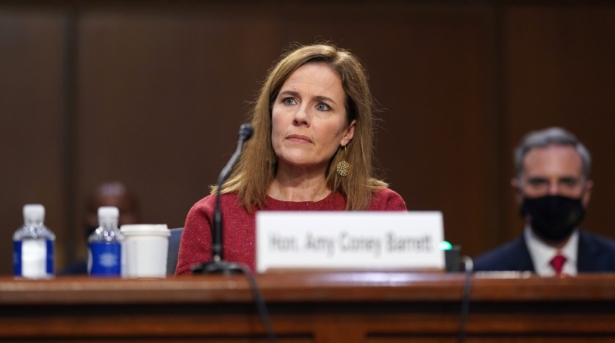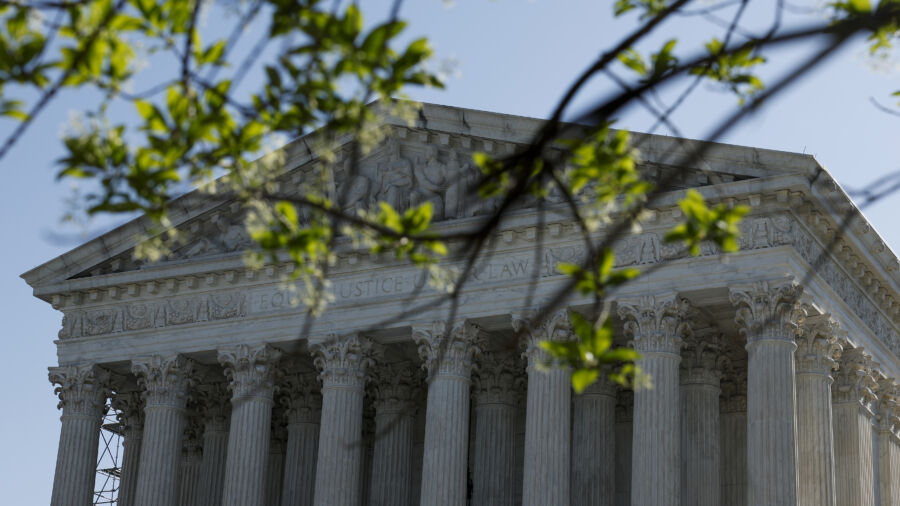In an 8-1 ruling, the U.S. Supreme Court on June 1 decided that a union’s deliberate destruction of company property as a pressure tactic in a labor dispute is not protected by federal law.
Labor activists have said that endangering and destroying company property during a dispute is fair game that has long been protected by the law, but companies like the petitioner in this case—Glacier Northwest a ready-mix concrete company headquartered in Seattle—pushed back.
Glacier Northwest does business as CalPortland.
The new ruling will allow companies to sue striking unions to hold them accountable for damage caused during labor actions.

The U.S. Supreme Court’s decision (pdf) in Glacier Northwest Inc. v. International Brotherhood of Teamsters Local Union No. 174 (court file 21-1449), allows the company to sue the union in state court.
Justice Amy Coney Barrett wrote the majority opinion. Justices Clarence Thomas and Samuel Alito both wrote separate concurring opinions. Justice Ketanji Brown Jackson was the sole dissenter.
The case goes back to August 2017 when cement mixer truck drivers decided to strike against Glacier. They loaded the vehicles with cement and left them on the company’s premises.
According to the union, drivers left the trucks running to prevent the cement from quickly hardening, becoming useless, and possibly damaging the trucks’ drums.
The company said in its petition the union deliberately sabotaged Glacier’s business and “coordinated with truck drivers to purposely time [a] strike when concrete was being batched and delivered” in an effort “to cause destruction of the concrete.”
Sudden Cessation of Work
On the first morning of the planned strike, “Union representatives knew there was a substantial volume of batched concrete in Glacier’s barrels, hoppers, and ready-mix trucks, [and] they called for a work stoppage.”
A union official made a throat-slashing gesture to signal a “sudden cessation of work.”
The company said the labor tactic caused “complete chaos” as it scrambled “to dispose of the concrete in a timely manner to avoid costly damage to the mixer trucks and in a manner so as not to create an environmental disaster.”
The strike went on for a week before a new collective bargaining agreement was reached.
Citing Washington state law, the company sued the union for intentional destruction of property. The union countered that state-law claims were by implication preempted under the Supreme Court’s decision in San Diego Building Trades Council v. Garmon (1959).

The company argued that although the federal National Labor Relations Act (NLRA) protects “peaceful methods of … economic pressure,” it does not allow a union to “enforce” its labor demands by way of “injury to property.”
The state-level trial court sided with the union, finding that the Garmon precedent shielded the Teamsters from state tort liability for intentional destruction of property.
The Washington Court of Appeals reversed that opinion, finding that “the intentional destruction of property during a lawful work stoppage is not protected activity” under the NLRA.
But the Washington Supreme Court overturned that ruling, reinstating the trial court’s dismissal of the company’s lawsuit. It found the union’s intentional destruction of company property was a “legitimate bargaining tactic” that trumps the state law’s interest in protecting property.
The U.S. Supreme Court reversed the decision of the Washington Supreme Court and remanded the case “for further proceedings not inconsistent with this opinion.”
‘Intent to Sabotage’ Property
Glacier depends on its drivers to deliver concrete to customers in a timely fashion but relations soured and the drivers went on strike, Barrett wrote in the court’s opinion.
The labor union “allegedly designed the strike with the intent to sabotage Glacier’s property” but the company deployed emergency measures to prevent damage to the trucks. The concrete itself went to waste and Glacier sued the union in state court for property destruction.
The lawsuit was dismissed by the state court, which reasoned that the companies’ claims were precluded by the NLRA.
But the state court should not have thrown out the case based on its concern that the company’s claim conflicted with the NLRA, Barrett wrote.
“Because the union took affirmative steps to endanger Glacier’s property rather than reasonable precautions to mitigate that risk, the NLRA does not arguably protect its conduct,” Barrett wrote.
In her dissenting opinion, Jackson, a liberal, noted that the National Labor Relations Board (NLRB) formally accused the company of unfair labor practices, asserting that the workers’ actions were “arguably protected.”
Eroding ‘Right to Strike’
The majority opinion fails “to heed Congress’s intent with respect to the [NLRB’s] primary role in adjudicating labor disputes, despite ostensibly applying Garmon, the bedrock case on that issue.”
The majority decision “is likely to cause considerable confusion among the lower courts about what Garmon requires. And any such confusion not only threatens to encroach upon the [NLRB’s] prerogatives, as Congress has assigned them, but also risks erosion of the right to strike.”
“Garmon makes clear that we have no business delving into this particular labor dispute at this time,” Jackson wrote.
“But instead of modestly standing down, the majority eagerly inserts itself into this conflict, proceeding to opine on the propriety of the union’s strike activity based on the facts alleged in the employer’s state-court complaint.”
The majority’s “misguided foray underscores the wisdom of Congress’s decision to create an agency that is uniquely positioned to evaluate the facts and apply the law in cases such as this one.
“This case is Exhibit A as to why the board—and not the courts—should ordinarily take the first crack at resolving contentious, fact-bound labor disputes of this nature,” Jackson wrote.
From The Epoch Times

